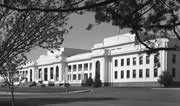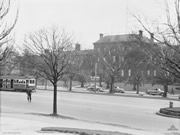
From 1939 to 1945 the Prime Minister, senior ministers and their staff, of necessity spent a great deal of their time at meetings, and some of the most important and frequent meetings were those of the Cabinet, the War Cabinet and the Advisory War Council.
With Canberra as the national capital and the seat of Parliament, Parliament House seemed the most appropriate venue for meetings. However Melbourne was the headquarters of the three armed services and the home of the Departments of Defence, Munitions, Supply and Development and of the War Cabinet Secretariat. Consequently, many meetings were held in Melbourne in the War Room of Victoria Barracks.
Robert Menzies preferred meetings in Melbourne as his home State was Victoria, and so did senior Ministers Casey, Street, Fairbairn and McEwen. However when John Curtin became Prime Minister he lived in the Lodge in Canberra and only two members of his War Cabinet lived in Victoria - Drakeford and Dedman.
Between September 1939 and 7 October 1941, during the Menzies and Fadden ministries, the War Cabinet held 82 meetings in Melbourne, 38 in Canberra, 16 in Sydney and one in Brisbane.
During the Curtin, Forde and Chifley ministries however, the War Cabinet held 44 meetings in Melbourne, 112 in Canberra and five in Sydney. The Advisory War Council met 47 times in Melbourne, 83 times in Canberra and 11 times in Sydney. 1
Rivalry between Melbourne and Canberra occasionally spilt over into the press. In the Sydney Morning Herald of 4 October 1941, Prime Minister designate Curtin indicated clearly that:
...Canberra was the seat of Australia’s Government, and his Government would operate from Canberra.
But he recognized, he added, that Army and Navy headquarters were in Melbourne. There would be no dragging of service chiefs away from their working headquarters for consultation with the Government. 2
Parliament House, Canberra
National Library of Australia: pic-an23490819-v
Victoria Barracks, 1943. View of main building looking
across St. Kilda Road.
Australian War Memorial: ID 052350
A few months later, the Canberra correspondent of the Sydney Morning Herald wrote:
The battle between Canberra and Melbourne for ranking as Australia’s war-time seat of government has again been joined, Melbourne, which counted the fight all but lost in December, has since acquired two new weapons. One is the claim that the reasons that make Mr Abbott’s committee [referring to the appointment of Mr Abbott to the chairmanship of the inter-Allied Committee] operate in Melbourne are just as telling in the case of War Council and War Cabinet. The other is the provision at Victoria Barracks, Melbourne, of a reconstructed War Cabinet room, fitted with appliances guaranteed to make even Melbourne weather endurable. 3
By 1944 however, the Sydney Morning Herald was reporting that Canberra had achieved:
a steady and almost completed growth to status as the nation's capital, in fact as well as in theory.
For that growth Canberra has chiefly to thank the literal implementing by the Prime Minister, Mr Curtin, of the doctrine which he had earlier proclaimed as Leader of the Opposition, that as far as practicable the functions of government should be exercised from the seat of government.
Under Mr Curtin Canberra has become the control station of the Australian war effort a strange sequel to 1939-40 moves which aimed at, and for a while succeeded in, installing Melbourne as Australia's real war-time capital. 4
Secure communication between these two key centres was crucial. The East Block building in Parliament House, Canberra, housed a small Defence Staff maintained to liaise with the Defence Department's centre at Victoria Barracks in Melbourne. A secure teleprinter link was established between the Canberra Defence office and the Department's headquarters in Victoria Barracks and secret telephone facilities were also available.

